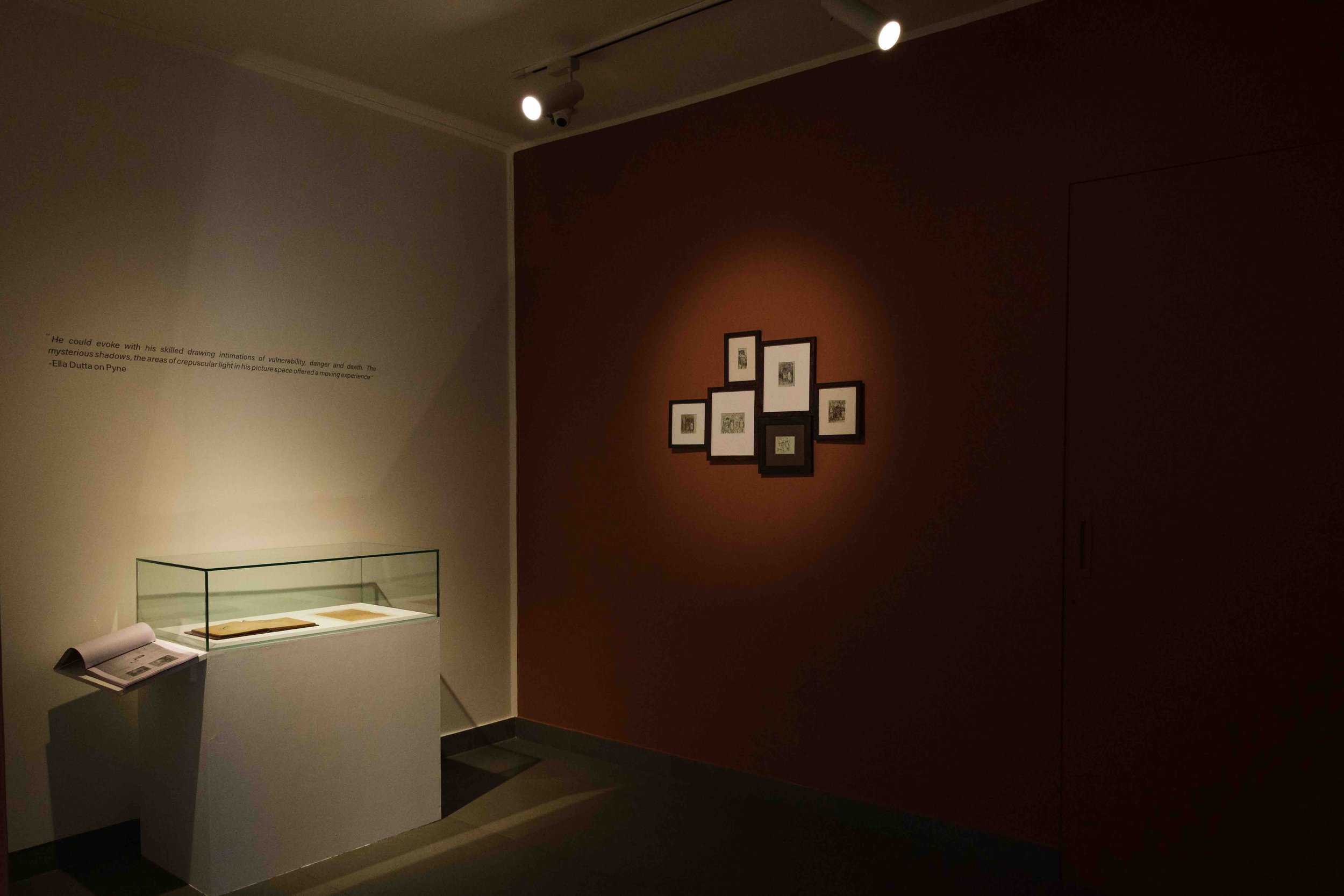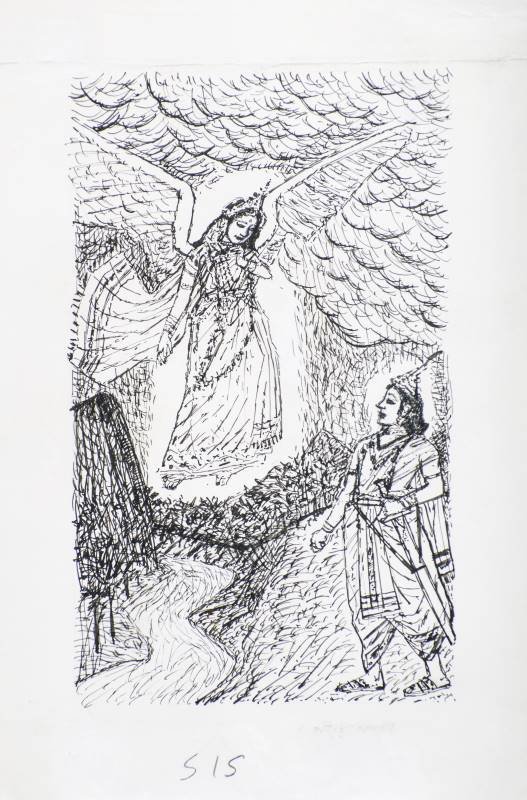
From the Shadows by Ganesh Pyne
April 27, 2022 – June 4, 2022 at Akar Prakar, Delhi
Born and brought up in Calcutta (present-day Kolkata) in 1937, Ganesh Pyne spent years of his life in a crumbling mansion in Kabiraj Row. Growing up during hard and turbulent times in the country, he found his reprieve from the dark reality outside in the mythologies and folktales narrated by his grandmother, Nandarani. The fantastical world created by her -stories became the basis of his artistic language years later.
Witnessing Abanindranath Tagore’s work in books and exhibitions in the early fifties in Calcutta, he was immensely influenced by his work and gained admission directly in the second year at the Government College of Art, Calcutta due to his proficiency. Later, he spent almost two decades of his life in Mander Mullick’s animation studio working as an illustrator. Though a difficult time in the artist’s life, the experience at the studio proved essential in the evolution of his visual language. A series of the 10 undated pen and ink illustrations in the exhibition exemplify the elements found in this medium, that appear in his tempera works as well.
To understand an artist’s practice, we must also look towards his process. For Pyne, his pen and ink ‘jottings’ were an integral part of this. In an interview with Ranjit Hoskote, Pyne remarks “When I sit down with my paper, I make ‘jottings’, which are preparatory works. I make different versions of an image, and then translate the one I like best into tempera on canvas.” With 45 framed fragments and whole jottings included in this show, salvaged from his diary, we are posed with a dilemma to regard them just as ‘preparatory works’. Created ritualistically over years of his practice, the ‘jottings’ are an independent practice by themself in his entire oeuvre.
Known for his tempera paintings, Ganesh Pyne’s visual language exhibits the influences of mystical abstraction. In an unsent letter found within the pages of his diary, while describing his work Pyne writes “Though a representational painter by nature, I keep my eyes open to the beauty created by purism and am eager to use the principles of abstraction in my works. Idealisation of forms, ornamentation and thoughts of my introvert mind often make my paintings ethereal and dreamy.”
The tempera on board Doors and Windows(1967) is a perfect example of this. Likely among the first of his paintings depicting the concept of ‘the doors and windows of a crumbling home’. A typical composition in his practice, the contrast of the ornamental and detailed grills of the house hides within itself the mysteries and darkness behind the doors and windows. The play of an almost eerie darkness in the composition enhances the contrast of light on the architecture.
From the artist’s archive, the exhibit also includes a diary of Pyne, with some of his jottings and daily journals entries along with a series of letters and drawings sent by him to his friend Saibal Ghosh, with conversations in Bengali translated to English, shedding a glimpse into his life at the time. Though a visual artist by profession, his writings and poems too illuminate the inner workings of the artist.
Pyne’s process and practice reflected in this exhibition of largely small format works is a passage into the mystical visual world created by him. The imageries carry within it the fantastical mind of the introverted and sensitive soul. The resoluteness to his art and the commitment to evolution in his practice are both exemplified in this exhibit of an artist regarded as a modern master in the history of Indian Art. From the Shadows aims to illuminate these rare works and archives including postcards, drawings, book illustrations, watercolours and a sneak peek into his personal diary from the 1960s. Offering a unique opportunity to view his life and work and understand the inner workings of the recluse artist's mind and art, almost a decade after his passing.
Curated by Siddhi Shailendra
Ganesh Pyne | Doors and Windows | Tempera | 13 x 15 in | 1967
Ganesh Pyne | Untitled | Water colour on paper | 4.5 x 3.5 in
Ganesh Pyne | Untitled | Mixed media | 7.25 x 8.25 in | 1979
Ganesh Pyne | Pori-r Golpo | Pen & Ink on paper | 8.5 x 5.5 in
Ganesh Pyne | Maniraj | Pen & Ink on paper | 8 x 5.5 in
Ganesh Pyne | Saat Bhai Champa | Pen & Ink on paper | 8 x 5.25 in
Ganesh Pyne | Untitled | Pen and ink on graph paper | 10 x 8 in
Ganesh Pyne | Untitled | Pen and ink on graph paper | 10 x 8 in
Ganesh Pyne | Untitled | Pen and ink on graph paper | 10 x 8 in
Ganesh Pyne
Ganesh Pyne, an Indian painter and draughtsman, was born in Calcutta in 1937. An introverted child, Pyne began sketching and doodling right from his childhood. Born and brought up in Calcutta, living in a crumbling family mansion in Kabiraj Row, north Calcutta, Pyne grew up listening to his grandmother’s folktales and reading fantasy stories from children’s books, which was to create the vocabulary of his future art. During his childhood years, he also flipped through Mouchak, a Bengali children’s magazine, to which his family subscribed to. In the magazine, he came across a printed drawing by Abanindranath Tagore, the founder of the Bengal school art movement, which had a deep impact on him. Thereafter he started reading avidly and drawing on the slate with chalk for hours. In 1946, he lost his father; and following the Calcutta riots, which preceded India’s partition, his family moved to a safe zone at the Calcutta Medical College. The trauma at the age of 9 had a lasting impact on his life and work.
After finishing school, he joined the Government College of Art & Craft in Calcutta. In 1959, he received his diploma in drawing and painting. Later, Pyne developed his own style of “poetic surrealism”, fantasy and dark imagery, around the themes of Bengali folklore and mythology. After graduating from art college, Pyne decided against taking up a full-time job and commenced his artistic career in the early 1960s as a book illustrator and a sketch artist for animation films at Mandar Mullick’s studio in Calcutta. In 1963, he became a member of the newly-formed Society of Contemporary Artists. His early work was deeply influenced by the Bengal school, especially Abanindranath Tagore, who was a major influence in watercolour. For the painter, the 1970s was an important period, when he moved to watercolours. The tumultuous period of anger and despair in Bengal found expression in his art. Pyne started as a watercolourist in the Bengal-school mode, and gradually shifted to gouache and tempera for his subsequent abstract and surrealist work in ochre, black and blue shades.
Ganesh Pyne is well known for his small-scale works in tempera on canvas, watercolour on paper and gouache. He also painted microcosmic images and motifs from the world of Bengali fables and fairy tales, including the Thakumar Jhuli and similar sources like the music and lyrics of Baul singers.














